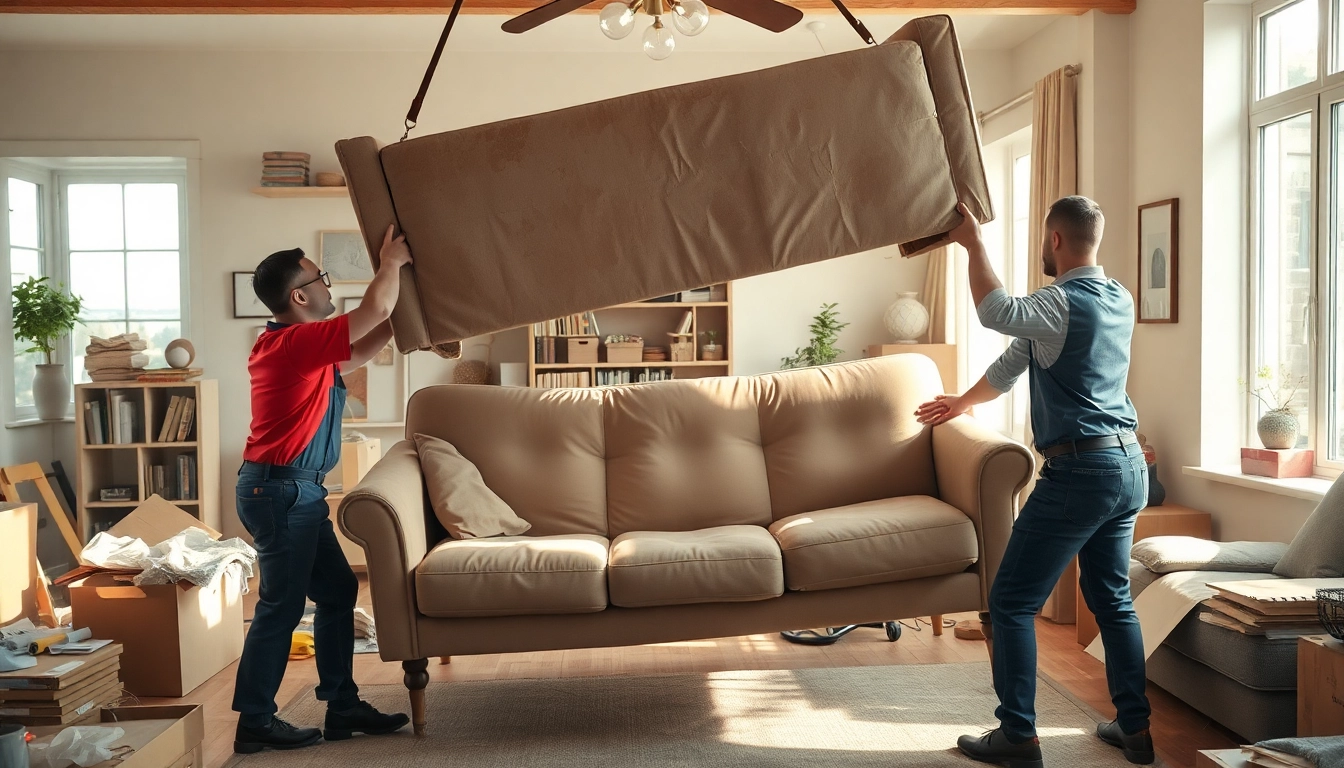Understanding the Need for Old Sofa Removal and Disposal
As homeowners, we often find ourselves attached to our furniture, especially our sofas, which serve as a focal point for comfort and relaxation. However, it’s crucial to recognize when it’s time to part ways with an old sofa. Proper Old Sofa Removal and Disposal not only makes room for new designs but also ensures we are being responsible stewards of our environment.
The Importance of Responsible Disposal
Responsible disposal of old furniture, particularly sofas, extends beyond mere aesthetics—it’s intertwined with ethical considerations surrounding waste management. Sofas are primarily composed of materials like fabric, wood, and foam, which, if not disposed of correctly, can contribute to significant environmental harm.
Furthermore, many regions have legal regulations that govern the disposal of bulky items, imposing fines on improper disposal or illegal dumping. Opting for respectful and environmentally friendly disposal methods safeguards your community, promotes sustainability, and may even yield tax benefits if you choose to donate.
Identifying When to Discard Your Old Sofa
Every sofa has a lifespan. Factors such as material quality, usage intensity, and maintenance contribute to its longevity. Knowing when to discard your sofa can save you from discomfort in the long run. Signs that it’s time to say goodbye include:
- Sagging cushions: If your cushions no longer provide support and have visibly sagged, it’s a sign of material failure.
- Unpleasant odors: Persistent smells can indicate mold or bacteria growth within the upholstery.
- Visible damage: Rips, tears, and stains that cannot be cleaned are not only unsightly but can impact hygiene.
- Allergens: Older sofas can trap dust mites and allergens, exacerbating respiratory issues.
Environmental Impact of Sofa Disposal
The impact of sofa disposal on the environment can be profound, especially when considering landfills. A standard sofa can take years to decompose and often contributes chemicals and toxins into the soil and water systems. Moreover, recycling options can significantly reduce waste associated with sofa disposal.
Understanding the lifecycle of your sofa, including its materials, can empower you to make informed disposal choices that prioritize sustainability. This can include exploring local recycling centers that accept furniture and initiatives that aim to divert waste from landfills.
Methods of Old Sofa Removal and Disposal
When it comes to removing your old sofa, there are various methods to consider, each with its own pros and cons. Understanding these options helps you select the best fit for your circumstances.
DIY Removal: Pros and Cons
Opting for a DIY approach allows for hands-on control over the removal and disposal process, potentially saving money in the long run. However, it’s essential to be aware of the challenges that come with this approach:
- Pros:
- Cost-effective, as there are no fees for hiring services.
- Ability to control the entire process, from removal to disposal.
- Opportunity to learn valuable skills, such as disassembly and transport.
- Cons:
- Physical strain of moving heavy furniture can lead to injury.
- Transportation logistics can be tricky without the right vehicle.
- The risk of improper disposal, leading to potential legal issues.
Hiring Professional Services for Old Sofa Removal and Disposal
Professional removal services offer a hassle-free solution for those who may lack the time, tools, or physical ability to remove and dispose of their old sofas. These services generally include:
- Expertise: Professionals understand the best methods for safely dismantling and removing your sofa.
- Efficient disposal: Many professional services prioritize eco-friendly disposal methods.
- Insurance coverage: Hiring licensed professionals protects you from liability in case of damages or injuries during the process.
While this method incurs costs, it often results in a quicker and more efficient outcome, freeing you to focus on more pressing matters.
Tips for Effective Sofa Removal
Regardless of which method you choose for sofa removal, following practical tips ensures the process goes smoothly:
- Plan your exit route. Ensure hallways and doors are free of obstacles.
- Get help. Don’t hesitate to enlist friends or family for assistance when lifting heavy items.
- Use a dolly or furniture slider to facilitate movement. These tools can help minimize strain and prevent damage to your floors.
- Wear protective gear. Keep your hands safe with gloves and consider wearing a back support belt.
Preparing Your Sofa for Removal
Before disposal, refreshing or dismantling your old sofa can enhance safety during transport and ensure an eco-friendly removal process.
Assessing Condition and Cleaning Before Disposal
Take time to assess the condition of your sofa. Cleaning it thoroughly not only makes it more presentable if you plan to donate but can also help identify any issues:
- Use a vacuum with an upholstery attachment to remove dust and allergens.
- Consider steam cleaning for lingering odors or stains.
- Check for bedbugs or other pests, especially if the sofa has been stored for long periods.
Disassembling Your Sofa: Step-by-Step Guide
If you plan to dismantle your sofa prior to removal, follow these steps:
- Remove cushions: Take off cushions and pillow covers to make the frame lighter.
- Take apart removable parts: If your sofa has removable legs, arms, or back, unscrew these components.
- Cut the fabric: Cut the upholstery along seams if necessary to expose the frame. Be careful not to damage the structure further.
- Separate materials: Sort components into recyclable materials (metal and wood) and those suitable for landfill.
Storing Temporary Solutions for Old Sofas
In cases where immediate removal isn’t feasible, it’s essential to have a short-term storage solution. Consider the following options:
- Cover the sofa: Use a protective cover to prevent dust and moisture damage.
- Choose a dry, ventilated location: Keep the sofa in a basement or attic to avoid exposure to the elements.
- Utilize space creatively: If possible, arrange your sofa in a way that doesn’t obstruct pathways or functional areas.
Cost Considerations for Old Sofa Removal and Disposal
Understanding the potential costs associated with sofa removal and disposal is crucial for effective budgeting. Costs vary significantly based on several factors:
Understanding the Pricing Models of Services
If you opt to hire a professional service, it’s essential to understand their pricing structure. Common pricing models include:
- Flat fees: A set price for the entire removal service, which often includes labor and disposal costs.
- Hourly rates: Some companies may charge based on the time taken to remove your sofa, particularly if additional help is required.
- Weight or volume-based pricing: This is based on how much weight or space your sofa occupies in their vehicle.
Potential Hidden Costs to Watch Out For
While planning for sofa removal, be aware of hidden costs that may arise:
- Special handling fees: Some sofas require special treatment due to size or materials.
- Travel fees: Depending on your area, some services charge for distance traveled.
- Disposal fees: If the service isn’t equipped for recycling, they may charge for landfill fees.
Budgeting Your Old Sofa Removal and Disposal Options
Start by assessing your available budget for sofa disposal. This will help you choose between DIY and professional services. Consider the following steps for effective budgeting:
- Research local disposal costs to gain a baseline.
- Acquire quotes from various services for price comparison.
- Factor in the potential value of donation to offset costs through tax deductions.
Finding Sustainable Disposal Options
Disposing of your old sofa should ideally align with sustainable practices. Understanding various disposal methods can provide clarity in making responsible choices.
Recycling vs. Landfill: Making the Right Choice
Recycling is the preferred method of disposal, allowing for materials to be repurposed rather than ending up in a landfill. However, not all materials can be recycled. Consider the following when choosing between recycling and landfill:
- Check local recycling rules and find centers that accept furniture.
- Assess the condition of your sofa. Usable sofas can often be refurbished, while broken ones may be beyond repair.
- It may be beneficial to contact local municipalities regarding special recycling collection events.
Donation Programs for Usable Furniture
Many organizations accept gently used furniture for donation, benefiting those in need while keeping items out of landfills. To ensure a successful donation:
- Research local charities and non-profits that accept furniture.
- Confirm that your sofa meets their criteria for condition and size.
- Schedule a pickup or drop-off ahead of time to streamline the process.
Community Resources for Eco-Friendly Disposal
In an era of heightened sustainability awareness, many communities have developed resources for responsible furniture disposal. Look for:
- Local freecycle groups that promote giving away usable items.
- Community clean-up days focusing on recycling bulky waste.
- Workshops on recycling and repurposing old furniture.



